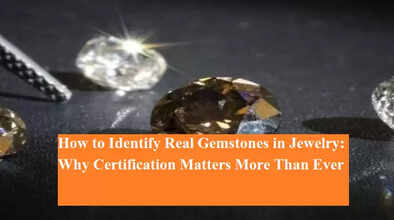How to Identify Real Gemstones in Jewelry: Why Certification Matters More Than Ever

Buying jewelry isn’t just about sparkling gold or intricate designs anymore—it’s about trust, authenticity, and long-term value. Whether you're eyeing a ruby, emerald, or sapphire, one crucial question remains: How do you know if the gemstone is real or fake?
As the Indian jewelry market continues to grow rapidly, consumers are becoming increasingly conscious about gemstone authenticity. With high-value stones becoming part of modern jewelry pieces, gemstone certification is emerging as a critical factor in every purchase.
Why Gemstone Certification is Important
A certified gemstone comes with a detailed report issued by an independent gemological laboratory. This certificate confirms whether the gemstone is natural or lab-grown and includes vital information such as:
-
The gemstone’s weight
-
Color and clarity
-
Any treatments or enhancements applied
-
Country or origin and type (natural or synthetic)
This report is not just paperwork—it’s a guarantee of authenticity.
What Experts Say
According to Ramit Kapoor of Gemological Science International (GSI), certification acts as a "guarantee" for buyers. GSI has laboratories in Jaipur, Mumbai, and other Indian cities where thousands of gemstones are examined daily. Kapoor emphasizes that for India’s jewelry industry to reach the government’s goal of becoming a $200 billion market by 2030, transparency and consumer confidence are non-negotiable.
Millennials and Gen Z Changing the Game
Younger buyers—including millennials and Gen Z—are now viewing gemstones not only as decorative items but also as investment assets. The presence of a trusted certification significantly boosts a stone’s resale value over time.
For instance, an emerald (panna) accompanied by an authentic certificate can appreciate greatly in value. Without certification, its credibility in the market diminishes, no matter how beautiful the piece looks.
Kapoor also notes that many buyers still don't fully understand the difference between natural and lab-grown diamonds. Both are real in terms of chemical composition and brilliance, but one is mined from the earth while the other is created in a lab. Certification helps eliminate this confusion, giving clarity to consumers.
What Should Buyers Check?
A certification report is only as reliable as the lab issuing it. Buyers should always ensure the lab is recognized by credible organizations such as:
-
Bureau of Indian Standards (BIS)
-
Responsible Jewellery Council (RJC)
Moreover, many leading labs now offer digital certificates that can be verified online. This not only provides convenience but also protects consumers from counterfeit stones and fake documentation.
Boosting Exports and Ethical Sourcing
As India’s gemstone exports grow globally, ethical sourcing and traceability are becoming essential. Certification ensures that each gemstone meets international standards and reveals important details about its origin and handling.
Transparency in sourcing also promotes ethical mining practices and boosts the image of Indian jewelers on the global stage.
Final Thoughts
The next time you're buying jewelry, especially one embedded with precious stones, don’t just admire the design—ask for the gemstone certificate. It could be the difference between a wise investment and a costly mistake.
Whether it's a lab-created diamond or a natural ruby, a certified gemstone gives you clarity, security, and value for money. With a growing demand for transparency in the jewelry industry, certification isn’t a luxury anymore—it’s a necessity.

